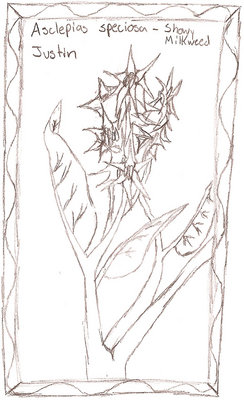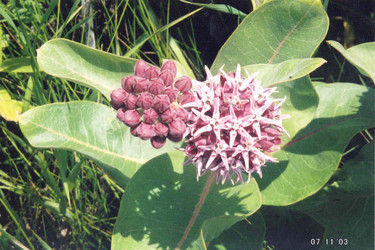Lakota Name: Paŋnuńpala Listen to Lakota Plant Name: Paŋnuńpala
Listen to Lakota Plant Name: Paŋnuńpala
Scientific name: Asclepias speciosa
Common name: Showy milkweed
Lakota Medicinal uses: Lakota resource lists showy milkweed as a medicinal but doesnt specify it's use.
Secondary compounds: Showy milkweed plants contain cardiac glycosides, making the material poisonous on ingestion. These glycosides cause electrolyte imbalances in heart muscle, resulting in arrhythmias and cardiac failure. Milkweeds can also produce proteinases in their latex. Milkweed produces the glycoside asclepain which is a proteinase that has been isolated from the latex of the showy milkweed. A proteinase is any enzyme that conducts proteolysis, that is, begins protein catabolism by hydrolysis of the peptide bonds that link amino acids together in the polypeptide chain. There are similarities between its properties and that of papain and bromelain both of which are known to be toxic.
Description and habitat: Showy milkweed (Asclepias speciosa) is a native perennial forb (non-woody plant with flowers) that grows from sea level to over 6,200 feet in elevation. It occurs in pastures and meadows, along streamsides, riparian zones, and ditch banks, and in waste areas. Regardless of specific location, this plant inhabits areas that remain moist through much of the summer.
Distribution in South Dakota: Common in dry to moist prairies over the state. The USDA Plant Database indicates that it is present in most counties across the state.
Distribution by State: AZ, CA, CO, IA, ID, IL, KS, MI, MN, MT, ND, NE, NM, NV, OK, OR, SD, TX, UT, WA, WI, WY
The only state the plant is endangered in is Iowa.
U.S. Weed Information: This plant can be weedy or invasive. It may be known by one or more common names in different places.






 Go to quick links
Go to quick search
Go to navigation for this section of the ToL site
Go to detailed links for the ToL site
Go to quick links
Go to quick search
Go to navigation for this section of the ToL site
Go to detailed links for the ToL site